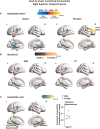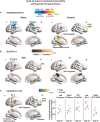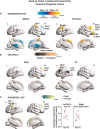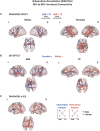Sex differences in autism: a resting-state fMRI investigation of functional brain connectivity in males and females
- PMID: 26989195
- PMCID: PMC4884321
- DOI: 10.1093/scan/nsw027
Sex differences in autism: a resting-state fMRI investigation of functional brain connectivity in males and females
Abstract
Autism spectrum disorders (ASD) are far more prevalent in males than in females. Little is known however about the differential neural expression of ASD in males and females. We used a resting-state fMRI-dataset comprising 42 males/42 females with ASD and 75 male/75 female typical-controls to examine whether autism-related alterations in intrinsic functional connectivity are similar or different in males and females, and particularly whether alterations reflect 'neural masculinization', as predicted by the Extreme Male Brain theory. Males and females showed a differential neural expression of ASD, characterized by highly consistent patterns of hypo-connectivity in males with ASD (compared to typical males), and hyper-connectivity in females with ASD (compared to typical females). Interestingly, patterns of hyper-connectivity in females with ASD reflected a shift towards the (high) connectivity levels seen in typical males (neural masculinization), whereas patterns of hypo-connectivity observed in males with ASD reflected a shift towards the (low) typical feminine connectivity patterns (neural feminization). Our data support the notion that ASD is a disorder of sexual differentiation rather than a disorder characterized by masculinization in both genders. Future work is needed to identify underlying factors such as sex hormonal alterations that drive these sex-specific neural expressions of ASD.
Keywords: autism spectrum disorders; functional connectivity; resting-state fMRI; sex differences.
© The Author (2016). Published by Oxford University Press. For Permissions, please email: journals.permissions@oup.com.
Figures




References
-
- Auyeung B., Baron-Cohen S., Ashwin E., Knickmeyer R., Taylor K., Hackett G. (2009). Fetal testosterone and autistic traits. The British Journal of Psychiatry, 100, 1–22. - PubMed
Publication types
MeSH terms
LinkOut - more resources
Full Text Sources
Other Literature Sources
Medical

